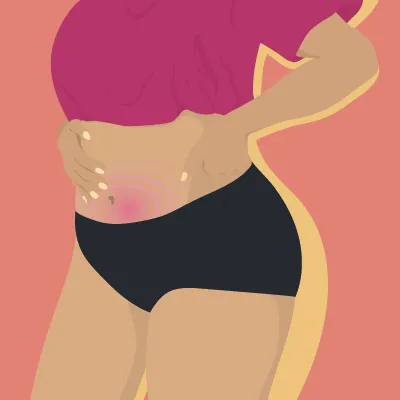Apr 09, 2021
Premenstrual Dysphoric Disorder (PMDD) Symptoms, Causes & Treatment
From mood swings, to aches and pains, to craving cake for breakfast… if you’ve had your period, chances are you’ve experienced some form of Premenstrual Syndrome! But, have you ever heard of Premenstrual Dysphoric Disorder? While PMS can undoubtedly put us out of sorts, PMDD is more than just feeling kinda sad or moody before that time of the month. Known as a more serious form of PMS, the effects of PMDD can be crippling enough to interfere with your day to day life. And since April is PMDD Awareness Month, Team Libra are here to shed a light on this rare, debilitating disorder. Join us as we explore the PMDD symptoms, causes and treatment options.
What is PMDD?
Premenstrual Dysphoric Disorder is a hormone-based mood disorder, defined by a negative reaction in the brain during the premenstrual phase of the cycle (around 7-10 days before your period starts). At this time, your oestrogen and progesterone levels are rising and falling – so naturally, there will be some changes to your emotional and physical health! Although, for those of us who experience PMDD, the intensity of these changes can frighteningly disrupt our daily routines, careers, relationships, and ultimately, our wellbeing. Affecting around 1 in 20 people who menstruate, common symptoms include feelings of depression, anxiety, severe physical pains, and much more. It’s been said that PMDD feels like “one week of hell, and three weeks of cleaning up.”
Why you might not have heard of it
PMDD has only recently been officially medically recognised, being added to the DSM-5 (Diagnostic and Statistical Manual of Mental Disorders) in 2013, and to the WHO ICD (World Health Organisation International Classification of Diseases and Related Health Problems) in 2019. This, in addition to PMDD being mistaken for PMS, explains why you may not have heard of it before. While more than 80% of us experience PMS, PMDD is much rarer, affecting between 3-8% of people with a period. This means there are fewer conversations surrounding the condition – something that we should all seek to change! More awareness for PMDD can help us to recognise the signs, which can lead to more women seeking positive, life-changing treatment.
How does PMDD differ to PMS
There’s much crossover between PMDD and PMS, such as emotional changes, fatigue, aches, pains and bloating. However, while many of us tend to experience these kinds of feels before our period, the symptoms are more severe in nature for women suffering from PMDD, meaning they’re not as easily managed. While PMS isn’t classified as a mental illness, PMDD is, so the diagnosis and treatment greatly differs between the two.
Causes and Symptoms
The causes of PMDD aren’t *exactly* known yet, but studies have shown that it could have a number of connections. Believed to be a hormonal sensitivity in the brain, PMDD may be genetic, and the hormonal changes that it’s linked to can potentially worsen symptoms of mood disorders, like depression and anxiety. For those of us with PMDD, the brain circuits that are activated by emotional responses may be different to those without it.
There are many potential symptoms of PMDD, including:
- Intense emotional changes and mood swings
- Irritability, anger, and interpersonal conflict
- Depression, feeling hopeless, unworthy or guilty
- Anxiety and nervous tension
- Reduced ability to cope or concentrate
- Feeling disinterested, withdrawn, and wanting to be alone
- Fatigue, low-energy, or lower libido
- Cravings and changes in appetite, wanting to eat more or less
- Affected sleep, either too much or not enough
- Feeling overwhelmed and a loss of control
- Aches and pains, like breast tenderness and headaches
- Weight gain, fluid retention or bloating
- Constipation and/or diarrhoea
- Skin problems, such as acne
- Poor coordination or clumsiness
Diagnosis and Treatment
PMDD can be a little tricky to diagnose, as there’s no medical test for it. Instead, it’s generally pinpointed through the monitoring of your body’s patterns over two or more menstrual cycles, specifically, what you experience emotionally and physically, in relation to the above symptoms. Normally, the presence of five or more of these symptoms is what determines a PMDD diagnosis. The good news is that PMDD can be treated and managed through medication, like anti-depressants and oral contraceptives, along with lifestyle changes, including exercise, healthy eating, and professional counselling.
Considering that we have around 450 periods over our lifetime, PMDD is a long term condition that calls for professional guidance to help lessen the impact on day-to-day life, relationships, careers, and emotional health. With the right diagnosis, treatment plan, compassion and understanding, PMDD doesn’t have to take over your quality of life! If you’re concerned or want to learn more, it’s always a good idea to book in a chat with your GP.
Love, Libra x
Anything else? Asaleo Care makes no warranties or representations regarding the completeness or accuracy of the information. This information should be used only as a guide and should not be relied upon as a substitute for professional, medical or other health professional advice.







